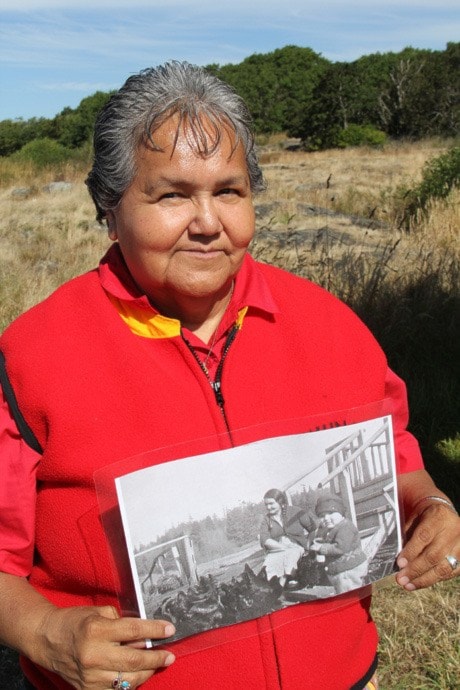Hands raised with a “hych’ka,” Joan Morris welcomes guests to Chatham Island.
“My name is Sellemah, my home is over there on Chatham One and I want to take this opportunity to welcome each and every one of you,” she said Wednesday, before the thank you in her Coast Salish tongue.
A childhood home, and place of refuge, Discovery and Chatham islands off the shores of Oak Bay are still a popular destination for quiet.
To Sellemah – her given name after her grandmother and the name she prefers – it’s still home, despite being removed for more than 50 years.
She lived the first 10 years of her life on the “beautiful” island.
“Everyone worked together. We had food. We never went hungry, never heard a cross word from the old ones,” Sellemah said, gazing across from Cattle Point before boarding a boat to visit. She lived there from 1947 to 1957. She was brought up by the “old ones” as her parents were hospitalized and unable to raise her. A topic she doesn’t delve into.
When the well dried up the families living on the island moved.
“It was home. I still consider it home,” said Sellemah.
The Songhees own Chatham Island and a fair chunk of Discovery Island, which is also the site of a provincial park. They are not disputed territories, but established reserves that have also been home to the Songhees for thousands of years.
“We had many leaders who went there to practise their culture because it was illegal,” said Lyle Henry, whose given name is Sie-amen-thet. Until the middle of the last century, the Canadian government attempted to assimilate the First Nations. The Indian Act banned displays of things like the Sun Dance, Potlach and other traditional cultures.
The Salish Sea sweeping around the lands offered quiet and relative remoteness providing protection for a traditional life and passing that culture to the next generation in a time when children were routinely whisked unwillingly away to residential schools. As Prime Minister Stephen Harper said in a 2008 apology, “Two primary objectives of the residential school system were to remove and isolate children from the influence of their homes, families, traditions and cultures, and to assimilate them into the dominant culture.
“These objectives were based on the assumption that aboriginal cultures and spiritual beliefs were inferior and unequal. Indeed, some sought, as was infamously said, ‘to kill the Indian in the child.’”
Chatham Island was a safe haven for young Sellemah.
Today, the tranquility makes the islands a prime destination for many recreational boaters. Unfortunately, they are trespassing and leave some unnerving damage such as toilets in the bush and the remains of raging campfires. Remnants of garbage speckle the beaches. One beach holds shotgun shells; trespassers took the time to strip the valuable brass tossing leftover plastic back to the beach. Perhaps its ignorance of the signs marking the islands as private property, Sellemah said.
“There’s a lot of improvement that has to be done, but I feel as one nation, we can do it, everybody working together,” she said.
Already, private boaters tackle the task of protecting the island, UVic studies the plant life, and the Songhees Nation is stepping up an education campaign with patrols and signage at Cattle Point and Oak Bay Marina.
Part Two: Coming together, The people who protect, restore the islands
Part Three: Moving forward, patrolling the private property
